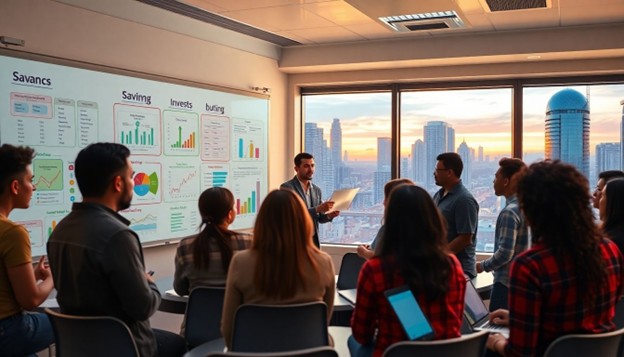The Role of Financial Education in Breaking the Poverty Cycle
Poverty is a tough puzzle that keeps many families stuck in a cycle
5/26/20253 min read


Poverty is a tough puzzle that keeps many families stuck in a cycle. Millions of people around the world face this challenge daily. It’s not just about money; it’s about opportunity, hope, and stability. Financial literacy is a powerful tool that can change lives. When people understand how money works, they gain the ability to improve their futures. The key idea here is simple: teaching financial skills can help people escape poverty and build stronger communities.
Understanding Poverty and Its Root Causes
Defining Poverty and Its Dimensions
Poverty isn’t just about not having enough money. It has many forms. Absolute poverty is when basic needs like food, shelter, and clothing are missing. Relative poverty is when people lack the income to participate fully in society. Poverty can also hurt a person’s mind and spirit, making it harder to see new possibilities. It’s a mix of social, economic, and psychological factors that trap many in a cycle.
Structural Barriers to Financial Stability
People in poverty often face barriers that seem impossible to overcome. These can include limited access to banks or credit. Systemic inequalities make it harder for some groups to get ahead. Many lack access to proper education about money or have no safe way to save and invest. These barriers keep many from breaking free and reaching financial stability.
The Intergenerational Nature of Poverty
Poverty tends to pass from one generation to the next. Kids in poverty often don’t learn how to manage money. Without that knowledge, they’re more likely to face the same struggles as their parents. Cases around the world show how this cycle continues year after year. Breaking this chain means changing how the next generation learns about money.
The Power of Financial Education in Poverty Alleviation
Building Financial Literacy Skills
Financial literacy teaches key skills like budgeting, saving, and managing debt. It helps people make better choices with their money. Research shows that when people understand money basics, they’re more likely to save and invest. Learning these skills empowers them to control their financial futures.
Enhancing Access to Financial Resources
Knowing about different financial products helps people use them wisely. It can prevent falling for scams or predatory loans. Well-informed individuals are better at choosing a bank account, a loan, or an insurance plan. Financial education can reduce debt problems and help families build savings.
Empowering Decision-Making and Self-Sufficiency
With financial knowledge, people become more confident in managing emergencies and planning for the future. It’s like having a safety net. Some programs combine microfinance with financial literacy. These initiatives help small entrepreneurs grow their businesses and improve their lives.
Effective Strategies for Implementing Financial Education
School-Based Financial Literacy Programs
Involving students in money education early helps build healthy habits. Many countries now include financial lessons in schools. These introduce kids to budgeting, saving, and understanding credit. Countries that focus on such programs see students better prepared for real-life money choices.
Community-Based Initiatives
Local workshops, peer talks, and partnerships with nonprofits are powerful too. They reach adults and families in need. For example, community programs in low-income neighborhoods show how group learning boosts confidence and skills. These efforts create a ripple effect in the community.
Digital Platforms and Technology
Apps, online courses, and virtual coaches make financial education accessible anytime. They’re especially helpful in rural or disconnected areas. However, challenges include internet access and tech literacy. Still, digital tools can reach more people faster than traditional methods.
Role of Policymakers and Financial Institutions
Policy Interventions and Regulations
Governments play a big role by creating national strategies for financial literacy. They can implement rules that require banks to provide clear information. Consumer protection laws ensure that people aren’t misled or taken advantage of. These policies make financial markets safer for everyone.
Corporate Social Responsibility and Banking Sector Initiatives
Many banks and companies are investing in community programs. They offer free workshops, savings plans, or financial counseling. These efforts show how the private sector can support financial learning. Successful programs build trust and promote smarter money decisions.
Fostering Public-Private Partnerships
By working together, governments, businesses, and nonprofits can extend their reach. Partnerships help fund larger programs and develop new ways to teach money skills. Combining resources ensures these programs will last and reach more people.
The Impact and Future of Financial Education in Poverty Eradication
Measuring Success and Outcomes
Progress can be seen in fewer families living in poverty, better savings habits, and more stable income. Studies link higher financial literacy to increased earnings and reduced debt. Tracking these results helps improve programs and policies.
Challenges and Limitations
Cultural differences, language barriers, and low literacy levels can slow progress. Misinformation or distrust in financial systems also hinders efforts. Overcoming these challenges needs tailored approaches and community trust.
Innovative Approaches and Emerging Trends
New tech, such as artificial intelligence, offers personalized learning. These tools adapt to each person’s needs, making learning easier. The future will see more interactive, engaging ways to teach financial skills.
Conclusion
Financial education is a key step in breaking the cycle of poverty. When individuals understand money, they gain power. Taking action now—through schools, communities, and policies—can put more people on a path to stability. Everyone has a role to play. Governments, businesses, and individuals must work together. Investing in financial literacy opens doors to a brighter, more equal future. Empowered people build stronger communities, and stronger communities build a better world.
